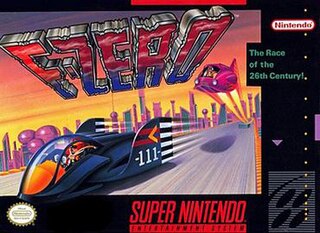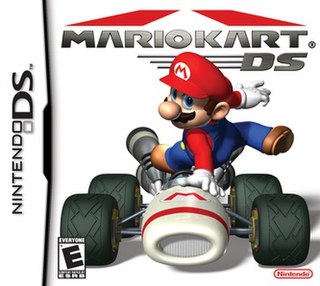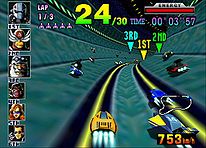Mario Kart is a series of kart racing games and a spin-off Mario franchise developed and published by Nintendo. Players compete in go-kart races while using various power-up items. It features characters and courses mostly from the Mario series as well as other gaming franchises such as The Legend of Zelda, Animal Crossing, F-Zero, Excitebike, and Splatoon.

Super Mario Kart is a kart racing game developed and published by Nintendo for the Super Nintendo Entertainment System (SNES). The first game in the Mario Kart series, it was released in Japan and North America in 1992, and in Europe the following year in 1993. Selling 8.76 million copies worldwide, the game went on to become the fourth best-selling SNES game of all time. Super Mario Kart was re-released on the Wii's Virtual Console in 2009, on the Wii U's Virtual Console in 2013, and on the New Nintendo 3DS's Virtual Console in 2016. Nintendo re-released Super Mario Kart in 2017 as part of the company's Super NES Classic Edition.

Mario Kart: Super Circuit is a 2001 kart racing game for the Game Boy Advance (GBA). It is the third Mario Kart game and retains its predecessors' gameplay: as a Mario franchise character, the player races opponents around tracks based on locales from the Super Mario platform games. Tracks contain obstacles and power-ups that respectively hamper and aid the player's progress. Super Circuit includes various single-player and multiplayer game modes, including a Grand Prix racing mode and a last man standing battle mode.

Mario Kart 64 is a kart racing video game developed and published by Nintendo for the Nintendo 64 (N64). It is the second main entry in the Mario Kart series and is the successor to Super Mario Kart (1992) for the Super Nintendo Entertainment System. It was released in Japan on December 14, 1996; in North America on February 10, 1997; in the United Kingdom on June 13, 1997; and in Europe on June 24, 1997. It was released for the iQue Player in China on December 25, 2003. It was released on the Wii and Wii U Virtual Console in 2007 and 2016, and on the Nintendo Switch Online + Expansion Pack on October 25, 2021.

Shigeru Miyamoto is a Japanese video game designer, producer and game director at Nintendo, where he serves as one of its representative directors as an executive since 2002. Widely regarded as one of the most accomplished and influential designers in video games, he is the creator of some of the most acclaimed and best-selling game franchises of all time, including Mario,The Legend of Zelda, Donkey Kong, Star Fox and Pikmin. More than 1 billion copies of games featuring franchises created by Miyamoto have been sold.

F-Zero is a racing game developed and published by Nintendo for the Super Nintendo Entertainment System (SNES). It was released in Japan on November 21, 1990, in North America in August 1991, and in Europe in 1992. F-Zero is the first game in the F-Zero series and was a launch game for the SNES. F-Zero was rereleased for the Virtual Console service on various Nintendo platforms and as part of the Super NES Classic Edition in 2017.

F-Zero X is a futuristic racing video game for the Nintendo 64 console. Developed and published by Nintendo, it was released in Japan, North America, and Europe in 1998. In 2000, the Expansion Kit was released in Japan, including a track and vehicle editor. The original game was ported in 2004 to the iQue Player in China. It had Virtual Console re-releases on the Wii in 2007 and the Wii U around nine years later. On March 11, 2022, the game was re-released on Nintendo Switch Online + Expansion Pack, featuring online multiplayer.

F-Zero GX is a 2003 racing video game developed by Amusement Vision and published by Nintendo for the GameCube console. It runs on an enhanced version of the engine used in Super Monkey Ball. F-Zero AX, the arcade counterpart of GX, uses the Triforce arcade system board conceived from a business alliance between Nintendo, Namco and Sega. Published by Sega, it was released alongside GX in 2003.

Mario Kart DS is a 2005 kart racing video game developed and published by Nintendo for the Nintendo DS handheld game console. It was released in November 2005 in North America, Europe, and Australia, and on December 8, 2005, in Japan. The game was re-released for the Wii U's Virtual Console in North America and PAL regions in April 2015 and in Japan in May 2016. The game is the fifth main entry in the Mario Kart series of video games, and the first to be playable via the Nintendo Wi-Fi Connection online service. Like other games in the series, Mario Kart DS features characters from the Mario series and pits them against each other as they race in karts on tracks based on locations in the Mario series.
Mario Kart Arcade GP is sub-series of arcade games from Nintendo's Mario Kart series developed specifically for arcades in collaboration with Namco. To date, four entries have been released - Mario Kart Arcade GP (2005), Mario Kart Arcade GP 2 (2007), Mario Kart Arcade GP DX (2013), and Mario Kart Arcade GP VR (2017). The first three entries are considered to be relatively rare outside of Japan, with the fourth title not seeing a release outside of Japan at all. The game's have been generally been well-received by critics, who have praised the game's transition of traditional Mario Kart gameplay into an arcade game format, thought to-date, while lamenting that none of the entries have been released outside of the arcade format onto any of Nintendo's home video game consoles.
Nintendo Fusion Tour was a touring rock music and video game festival sponsored by Nintendo, which began in 2003.

The GameCube is one of Nintendo's home video game consoles and part of the sixth generation of video game consoles. Although the competing PlayStation 2 and Xbox consoles supported substantial amounts of online games, the GameCube had only eight games with internet or local area network (LAN) support. Nintendo never commissioned any servers or internet services to interface with the console, but allowed other publishers to do so and made them responsible for managing the online experiences for their games. Nintendo remained pensive with its online strategy for the duration of the GameCube's lifespan, defiant of growing interest from players and the success of Microsoft's Xbox Live online service. Company leaders including Shigeru Miyamoto and Satoru Iwata based their stance on concerns with maintaining quality control over their games and doubts that players would want to pay subscription fees.

Donkey Kong Barrel Blast is a 2007 racing game for Nintendo's Wii video game console. The game was shown at the E3 convention in May 2006 for the GameCube under the title of DK: Bongo Blast, but this version was ultimately cancelled in favor of a Wii release. It was released for the Wii in Japan and the United States in 2007, and in PAL regions in 2008 with the title Donkey Kong Jet Race.

Mario Kart Wii is a 2008 kart racing game developed and published by Nintendo for the Wii. It is the sixth installment in the Mario Kart series, and was released in April 2008. Like its previous installments, Mario Kart Wii incorporates playable characters from the Mario series, who participate in races on 32 different race tracks using specialized items to hinder opponents or gain advantages. The game features multiple single-player and multiplayer game modes including two- to four-person split screen. Online multiplayer was supported until the discontinuation of Nintendo Wi-Fi Connection in May 2014. Mario Kart Wii uses the Wii Remote's motion-controls to provide intuitive and conventional steering controls. Each copy of the game was bundled with the Wii Wheel accessory to augment this feature and mimic a steering wheel.
Ever since Pole Position in 1982, Formula One (F1) has always played a part of the racing genre in video games. Early Formula One games were typically arcade racing games, before Formula One Grand Prix (1991) popularized Formula One racing simulations on home computers.

Mario is a Japanese multimedia franchise created by Japanese game designer Shigeru Miyamoto for video game company Nintendo, which produces and publishes its installments. Starring the titular Italian plumber Mario, it is primarily a video game franchise but has extended to other forms of media, including television series, comic books, a 1993 feature film, a 2023 animated film, and theme park attractions. The series' first installment was 1983's Mario Bros., although Mario made his first appearance in 1981's arcade game Donkey Kong and had already been featured in several games of the Donkey Kong and Game & Watch series. The Mario games have been developed by a wide variety of developers, including Nintendo, Hudson Soft, and AlphaDream. Mario games have been released almost exclusively for Nintendo's various video game consoles and handhelds, from the third generation onward.

F-Zero Climax is a racing video game developed by Suzak Inc. and published by Nintendo for the Game Boy Advance (GBA) handheld console. The game was released in Japan on October 21, 2004 and was the last F-Zero installment for the next 19 years.














